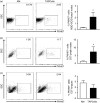Melanoma cell lysate induces CCR7 expression and in vivo migration to draining lymph nodes of therapeutic human dendritic cells
- PMID: 24673602
- PMCID: PMC4080955
- DOI: 10.1111/imm.12264
Melanoma cell lysate induces CCR7 expression and in vivo migration to draining lymph nodes of therapeutic human dendritic cells
Abstract
We have previously reported a novel method for the production of tumour-antigen-presenting cells (referred to as TAPCells) that are currently being used in cancer therapy, using an allogeneic melanoma-derived cell lysate (referred to as TRIMEL) as an antigen provider and activation factor. It was recently demonstrated that TAPCell-based immunotherapy induces T-cell-mediated immune responses resulting in improved long-term survival of stage IV melanoma patients. Clinically, dendritic cell (DC) migration from injected sites to lymph nodes is an important requirement for an effective anti-tumour immunization. This mobilization of DCs is mainly driven by the C-C chemokine receptor type 7 (CCR7), which is up-regulated on mature DCs. Using flow cytometry and immunohistochemistry, we investigated if TRIMEL was capable of inducing the expression of the CCR7 on TAPCells and enhancing their migration in vitro, as well as their in vivo relocation to lymph nodes in an ectopic xenograft animal model. Our results confirmed that TRIMEL induces a phenotypic maturation and increases the expression of surface CCR7 on melanoma patient-derived DCs, and also on the monocytic/macrophage cell line THP-1. Moreover, in vitro assays showed that TRIMEL-stimulated DCs and THP-1 cells were capable of migrating specifically in the presence of the CCR7 ligand CCL19. Finally, we demonstrated that TAPCells could migrate in vivo from the injection site into the draining lymph nodes. This work contributes to an increased understanding of the biology of DCs produced ex vivo allowing the design of new strategies for effective DC-based vaccines for treating aggressive melanomas.
Keywords: CCR7; dendritic cells; immunotherapy; melanoma; migration; tumour lysates.
© 2014 John Wiley & Sons Ltd.
Figures





Similar articles
-
CC chemokine receptor-7 on dendritic cells is induced after interaction with apoptotic tumor cells: critical role in migration from the tumor site to draining lymph nodes.Cancer Res. 2000 Apr 15;60(8):2209-17. Cancer Res. 2000. PMID: 10786686
-
Blockade of CCR7 leads to decreased dendritic cell migration to draining lymph nodes and promotes graft survival in low-risk corneal transplantation.Exp Eye Res. 2016 May;146:1-6. doi: 10.1016/j.exer.2015.12.004. Epub 2015 Dec 12. Exp Eye Res. 2016. PMID: 26689751
-
Augmentation of the migratory ability of DC-based vaccine into regional lymph nodes by efficient CCR7 gene transduction.Gene Ther. 2005 Jan;12(2):129-39. doi: 10.1038/sj.gt.3302358. Gene Ther. 2005. PMID: 15483669
-
Dendritic cell gene therapy.Surg Oncol Clin N Am. 2002 Jul;11(3):645-60. doi: 10.1016/s1055-3207(02)00027-3. Surg Oncol Clin N Am. 2002. PMID: 12487060 Review.
-
Dendritic cell migration through the lymphatic vasculature to lymph nodes.Adv Immunol. 2013;120:51-68. doi: 10.1016/B978-0-12-417028-5.00002-8. Adv Immunol. 2013. PMID: 24070380 Review.
Cited by
-
Antimelanoma Effects of Concomitant Inhibition of SIRT1 and SIRT3 in BrafV600E/PtenNULL Mice.J Invest Dermatol. 2022 Apr;142(4):1145-1157.e7. doi: 10.1016/j.jid.2021.08.434. Epub 2021 Sep 29. J Invest Dermatol. 2022. PMID: 34597611 Free PMC article.
-
Dendritic Cell-Based Cancer Vaccines: The Impact of Modulating Innate Lymphoid Cells on Anti-Tumor Efficacy.Cells. 2025 May 30;14(11):812. doi: 10.3390/cells14110812. Cells. 2025. PMID: 40497988 Free PMC article. Review.
-
In-Depth Analysis of the Impact of Different Serum-Free Media on the Production of Clinical Grade Dendritic Cells for Cancer Immunotherapy.Front Immunol. 2021 Feb 5;11:593363. doi: 10.3389/fimmu.2020.593363. eCollection 2020. Front Immunol. 2021. PMID: 33613517 Free PMC article.
-
Proteomic Identification of Heat Shock-Induced Danger Signals in a Melanoma Cell Lysate Used in Dendritic Cell-Based Cancer Immunotherapy.J Immunol Res. 2018 Mar 18;2018:3982942. doi: 10.1155/2018/3982942. eCollection 2018. J Immunol Res. 2018. PMID: 29744371 Free PMC article.
-
Oncolysate-loaded Escherichia coli bacterial ghosts enhance the stimulatory capacity of human dendritic cells.Cancer Immunol Immunother. 2017 Feb;66(2):149-159. doi: 10.1007/s00262-016-1932-4. Epub 2016 Nov 18. Cancer Immunol Immunother. 2017. PMID: 27864613 Free PMC article.
References
Publication types
MeSH terms
Substances
LinkOut - more resources
Full Text Sources
Other Literature Sources
Medical

